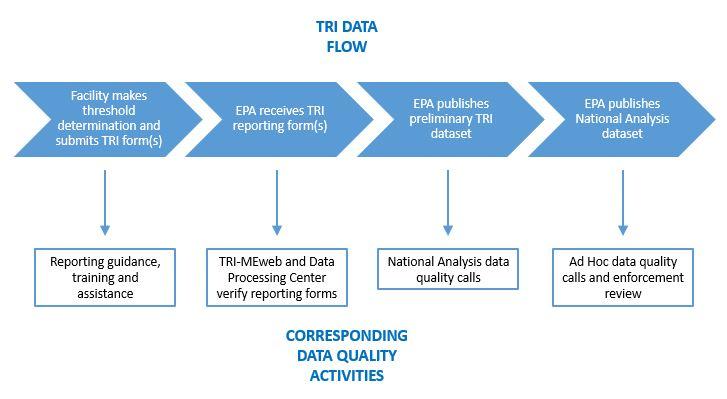TRI Data Quality
Across communities, industries, universities, and governments, people use Toxics Release Inventory (TRI) data to inform decisions and influence outcomes. The TRI Program works collaboratively with industrial facilities to assist them in collecting and submitting accurate TRI data.
On this page:
- What resources are available to help facilities collect and submit accurate TRI data?
- How does the TRI Program help facilities optimize the quality of TRI data?
- What legal requirements apply to the submission of accurate TRI data?
What resources are available to help facilities collect and submit accurate TRI data?
The TRI Program is committed to helping reporting facilities submit high-quality TRI data. We provide reporting software with built-in data quality alerts, produce online training and guidance materials (including chemical- and industry-specific guidance), manage an information call center (“TRI hotline”) to answer facility representatives’ questions, and assist facilities through the data quality call process (described below). The TRI Program also created the “GuideME” tool, a searchable database that contains all TRI guidance materials in one cross-referenced location.
Many industry trade associations have developed their own guidance documents to help facilities determine reportable chemical quantities, comply with all TRI requirements, and report high-quality data. Additionally, some facilities develop their own site-specific emission factors to improve the accuracy of their TRI data.
How does the TRI Program help facilities optimize the quality of TRI data?
In 2013, the TRI Program began requiring facilities to prepare and submit TRI reporting forms electronically using TRI-MEweb. This online software prevents many reporting errors that were common on the previously used paper reporting forms. Additionally, TRI-MEweb prompts facilities to check the data on their forms for a variety of potential issues. Once facilities certify and submit their reporting forms, the TRI Program begins reviewing TRI submissions. The diagram below summarizes the steps in the TRI data collection process and where in the process we conduct data quality activities. 
Each year, the TRI Program contacts certain facilities as part of the TRI data quality process. We typically conduct data quality phone calls in two phases: in the summer immediately following the July 1 reporting deadline (referred to as “National Analysis data quality calls”) and in early spring of the following calendar year (referred to as “Ad hoc data quality calls”).
The TRI Program makes National Analysis data quality calls primarily to verify the accuracy of reported information being used to develop the annual TRI National Analysis. These calls focus on facilities:
- reporting the largest increases or decreases of releases or other waste management quantities from the previous reporting year;
- reporting the largest releases of persistent bioaccumulative toxic chemicals (PBTs);
- reporting the largest releases to air or water; and
- with the highest risk-screening scores and the largest changes in scores from the previous year.
Ad hoc data quality calls focus on topics that vary from year to year and may include facilities reporting:
- invalid industrial classification codes;
- dioxin releases without an accompanying Form R Schedule 1;
- low or zero air release quantities for volatile TRI chemicals despite reporting a large amount of the chemical on-site;
- identical release quantities in subsequent reporting years; and
- to other EPA/non-EPA programs but not to the TRI Program.
We also contact facilities that submitted TRI data in the previous reporting year but not in the current reporting year. These communications are intended to either prompt facilities to submit TRI reporting forms or to verify that facilities have valid reasons for discontinuing reporting.
Throughout the year, the TRI Program also encourages facilities to make changes to their TRI reporting forms (revisions or withdrawals) if more accurate information becomes available. In addition, EPA may take enforcement action(s) when required TRI reporting forms are not filed and/or filed reporting forms have significant data quality issues. For more information, visit the TRI Compliance and Enforcement webpage.
What legal requirements apply to the submission of accurate TRI data?
Section 313 of the Emergency Planning and Community Right-to-Know Act (EPCRA) and Section 6607 of the Pollution Prevention Act (PPA) require certain industrial facilities to report release and other waste management quantities of TRI-listed chemicals annually when a reporting threshold is triggered, but these statutes do not impose any monitoring burden for determining the quantities.
Some facilities are required to measure or monitor emission or other waste management quantities due to regulations unrelated to the TRI Program, or due to company policies. These existing, readily available data are often used by facilities for TRI reporting purposes. When measured (e.g., monitoring) data are not “readily available,” or are known to be non-representative for TRI reporting purposes, the TRI regulations require that facilities determine release and other waste management quantities of TRI-listed chemicals by making “reasonable estimates.”
